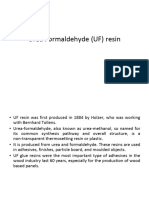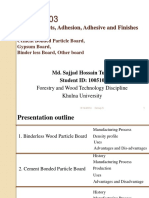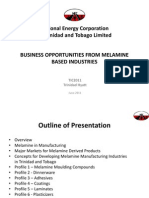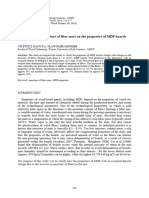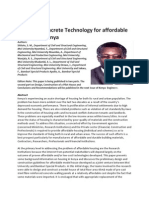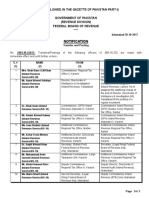Manufacture of Urea - Melamine - Formaldehyde Glue Used For Laminated Veneer Lumber Production
Manufacture of Urea - Melamine - Formaldehyde Glue Used For Laminated Veneer Lumber Production
Uploaded by
Phan KhánhCopyright:
Available Formats
Manufacture of Urea - Melamine - Formaldehyde Glue Used For Laminated Veneer Lumber Production
Manufacture of Urea - Melamine - Formaldehyde Glue Used For Laminated Veneer Lumber Production
Uploaded by
Phan KhánhOriginal Title
Copyright
Available Formats
Share this document
Did you find this document useful?
Is this content inappropriate?
Copyright:
Available Formats
Manufacture of Urea - Melamine - Formaldehyde Glue Used For Laminated Veneer Lumber Production
Manufacture of Urea - Melamine - Formaldehyde Glue Used For Laminated Veneer Lumber Production
Uploaded by
Phan KhánhCopyright:
Available Formats
Forest Industry
MANUFACTURE OF UREA - MELAMINE - FORMALDEHYDE GLUE
USED FOR LAMINATED VENEER LUMBER PRODUCTION
Tran Van Chu1, Trinh Hien Mai2, Ly Tuan Truong3
1,2,3
Vietnam National University of Forestry
SUMMARY
In this study, glue Urea - Melamine- Formaldehyde (UMF) was created to produce laminated veneer lumber
(LVL), then the quality of LVL produced from Urea-Formaldehyde glue (UF) of Gia Han Company was
compared to that of LVL produced from UMF made in Laboratory of Wood Industry College, Vietnam
National University of Forestry (VNUF). The research results show that: The technology of producing UMF
glue and LVL is suitable with current production condition and can be well applied in Vietnam. This
technological process has been tested and applied in production at some factories and enterprises in Vietnam.
The UMF glue produced in this study was a good adhesive and met the requirements of a glue used for high-
quality LVL production. The quality criteria of the UMF glue were much better than those of UF glue from Gia
Han Company. Some quality criteria of LVL produced from the UMF reached the requirements of the
standards CAN3 - 0437 - M85 and JAS S-11-15.2. The LVL produced from the UMF glue can be used for
furniture and construction.
Keywords: Fast growing plantation wood, Laminated Veneer Lumber, Urea - Formaldehyde glue, Urea -
Melamine - Formaldehyde glue.
I. INTRODUCTION high frequency pressing. All of those methods
In recent years, the forest products to produce LVL are very strict in pressing
processing industry in Vietnam has been parameters and especially adhesives and
growing very well, confirming very important additives.
position and role of the sector in the This happens as LVL has great thickness
development of the national economy. One of and includes many parallel veneers. Heat is
the reasons for this success is the right policy difficult to transmit into the core layer
in science and technology to promote the (veneer), this affects the bonding quality of
processing of forest products, including the LVL product. The glue should have high solid
technology of wood-based panel production. content, high viscosity, permeability into
Among the kinds of wood-based panels, veneers, good spreading, high elasticity, etc.
LVL possesses a lot of valuable properties and Most of the UF glues used for plywood and
is widely used to replace timber in particle board in Vietnam market is not
construction, such as girders, beams, door suitable to produce high quality LVL.
frames, window or bending details. LVL can Therefore, the study to create an UF glue
improve some disadvantages of natural wood with appropriate quality criteria for LVL
such as more uniform in properties, better production from plantation wood, in
weather resistance, large-sized details technological condition of Vietnam is a very
overcoming the limitations of tree’s diameter essential and meaningful task. There have been
and height (especially for plantation timber). many solutions to enhance the quality of the
LVL’s structure is similar as that of glue. One of these solutions is modification of
plywood, however LVL is thicker than UF glue by different chemicals, such as
plywood and the veneer grains are arranged phenol, melamine, epoxy, etc.
parallel. There are 3 methods to create LVL: This article presents the modification of UF
step by step pressing, once step pressing and glue by melamine to create UMF glue used for
102 JOURNAL OF FOREST SCIENCE AND TECHNOLOGY NO. 5 - 2016
Forest Industry
LVL production in technological condition of c. Formaldehyde (H-CHO). Formaldehyde
Vietnam. was produced in Duc Giang Chemical Factory.
II. MATERIALS AND METHODS Some basic properties: Liquid, colorless,
2.1. Raw materials used in the experiments molecular mass: 60; density: 1:05 g/cm3.
2.1.1. Round wood Content of other substances in Formaldehyde:
Wood used in the experiments was Styrax Cl 0.0002%, SO4 0.001%, Fe 0.0002%, Pb
tonkinensis. Pierre at age of 7-8 years and 0.0002%.
harvested from Doan Hung District, Phu Tho d. Caustic soda (NaOH): NaOH was
Province. Styrax tonkinensis. Pierre is a very produced in Duc Giang Chemical Factory.
flammable wood, pinkish white, heart wood Some basic properties: crystalline, white,
and sap wood are differentiable, timber vessels soluble in water, molecular weight: 40;
are scattered single or dual, diameter of timber density: 2.13 g/cm3 melting point: 321oC.
vessels varies from 100-200 µm, parenchyma Content of other substances in Caustic soda:
cells arrange along the trunk, uniform arranged Na2CO3<0.005%, SO4 0.005%, Cl 0.005%, N
rays are accounted for 10-30% of the timber
0.001%, PO4 0.001%, SiO3 0.01%, Fe 0.003%,
volume, there is no texture layer and glue tube,
Ca 0.01%, K 0.05%.
cellulose content is 47-49%, lignin content is
d. Amoniclorua (NH4Cl): NH4Cl was
22.3%. The wood basic density is 0.38-0.41g
produced in Duc Giang Chemical Factory.
/cm3, shrinkage coefficient: 0.29, parallel
Some basic properties as follows: crystalline,
compression strength: 192.105N /m2, static
white, soluble in water.
bending strength: 505.105N /m2, low natural
durability, easy processing and easy cracking. g. Glue used for control LVL: The glue
The above mechanical, physical and used in the experiments for control LVL
chemical properties of Styrax tonkinensis. production was Urea-formaldehyde (UF) of
Pierre show that the wood can fully meet the Gia Han Company, Taiwan. This is one of the
requirements of raw material used for LVL glues used widely in many Southeast Asian
production technology. countries such as Malaysia, Indonesia,
2.1.2. Chemicals Thailand. In Vietnam, glues of Gia Han
a. Urea (H2N-CO-NH2): Urea was Company have been used extensively in
produced in Duc Giang Chemical Factory. factories of plywood, LVL and particleboard
Some basic properties: crystal, colorless, production.
soluble in water and oil, hygroscopic, 2.2. Experimental methods
molecular mass: 60; density: 1.335 g/cm3, 2.2.1. Prescription and process of making
water soluble at 20oC: 104.7g/100g H2O, UMF glue
melting temperature: 132oC. Content of a. Prescription of making UMF glue
substances in Urea: Cl 0.0003%, SO4 0.001%, Urea 98%: 350 pbw; Melamine 99%: 10
NH3 0.005%, Fe 0.0002%, Pb 0.0002%. pbw; Formaldehyde 37%: 700 pbw; NaOH
b. Melanine (C3H6N6): Melamine is an 10%: a sufficient amount; NaCl 20%: a
organic base, low water soluble, chemical sufficient amount.
formula is C3H6N6, white powder. Other names: b. Process of making UMF glue
2,4,6-Triamino-s-triazine, Cyanurotriamide, Use a technical balance with precision of
Cyanuramide. Melamine used in this study was 0.01g to weight the chemicals: urea, melamine
produced by Chengdu Yulong Chemical Co. Ltd, and formaldehyde. Pour the amount of
China. formaldehyde in the glue pot. Use NaOH 10%
JOURNAL OF FOREST SCIENCE AND TECHNOLOGY NO. 5 - 2016 103
Forest Industry
to adjust the pH of formaldehyde to 7.5-8.5. NaOH to neutralize, adjust the pH to 7.0-7.5,
Pour 2/3 amount of urea (first time) and entire then pour 1/3 amount of urea (second time)
amount of melamine into the glue pot. Stir and stir well, then cool the solution. When the
carefully until urea and melamine were well temperature in the glue pot was about 400C,
dissolved. Increase the temperature of the finish the cooking process.
solution up to 90+/-1oC in 40-50 minutes, 2.2.2. Quality of the experiment boards
simultaneously maintain this temperature for LVL thickness: 35mm; number of veneers:
about 30 minutes. NH4Cl solution was used to 15; veneer thickness: 3.6mm; veneer moisture
adjust pH of the solution to 4.8-5.0 until the content after drying: 10%; veneer moisture
end of the reaction. content after glue spreading: 20%. Quality of
When the reaction ended, immediately use LVL were tested as the standards in table 01.
Table 01. Testing standards of LVL
N0 Criteria Sign Unit Testing standard
1 Thickness swelling TS % CAN3 – 0437 – M85
2 Shear strength T MPa JAS S-11-15.2
3 Modulus of rupture MOE MPa CAN3 – 0437 – M85
2.2.3. Process of producing LVL is presented in figure 01:
In this study, the process of producing LVL
Round wood Checking the quality Log cutting Heat treatment
Glue Checking the quality Veneer drying Veneer peeling
Pre-pressing Lay up Glue application Veneer grading and machinering
ssspreding
Hot pressing Sanding, Sawing LVL product
Figure 01. Technical process of producing LVL
After harvesting, Styrax tonkinensis. Pierre After the heat treatment, the logs were
wood with diameter of 20-25cm were debarked peeled to create veneers with thickness of 3.6
and cut into logs with a length of 1.35m. Then mm. Here were the parameters of peeling
the wood was boiled in water (heat treatment) lathe: sharpness angle (β): 20o; clearance
before peeling. The purpose of heat treatment angle (α): 3o; vertical distance (h) between
was to soften the wood before peeling and knife edge and spindle axis: +1mm; speed of
remove some of the wood extractives. chuck spindle: 150 r/min; speed of knife
Parameters of the heat treatment: Temperature: movement (peeling speed): 5.8 mm/s; vertical
60-70oC; Time: 9-10 hours; cooling to the distance (ho) between nose bar and knife edge:
environment temperature: 2 hours. 0.3 mm; compression rate (Δ): 20%.
104 JOURNAL OF FOREST SCIENCE AND TECHNOLOGY NO. 5 - 2016
Forest Industry
After peeling, the wet veneers were dried by for 5 minutes and let stand for 5 minutes again.
a roller kiln (with air circulation along the axis Then use a pH meter to measure the pH value
of the kiln. Required moisture content of the of the veneer.
veneers after drying was 10%, moisture Resistance to acid of veneer was measured
content of the veneers after glue spreading was as place 25 g wood power in a triangle glass
20%. The parameters of veneer drying: inlet bottle at room temperature. Pour 250 ml of
temperature: T = 60 - 70oC; outlet temperature: distilled water in the bottle and shake well for
T = 110 - 120oC; roller speed: 0.75 m/s; air 20 minutes. After cooling to room temperature,
circulation speed: V = 3m/s. Veneer quality pour the solution into the filtering device. Add
after drying as follows: depth of checks: 49.52- 2 cups of glass (350 ml) each contained 50ml
60.11%; frequency of checks: 4.02 – 5.13 purification water. Calibrate with a solution of
marks/cm; thickness variation: 1.77 - 2.46%; 0.025 mol/l sulfuric acid to pH = 3. Number of
recovery rate of veneer: 55 - 62%. Color of the sulfuric acid mol used is called resistance to
veneers after drying was similar as that of the acids of the veneer.
natural timber. The veneers with such quality Some quality criteria of LVL were tested on
criteria met entirely the requirements of a physical and mechanical testing machine, at
materials used for LVL and plywood. the Laboratory of Wood Industry College,
The UMF glue was stabilized and tested Vietnam National University of Forestry
quality before using. Then the veneers were (VNUF).
spreaded by UMF glue and layed up. UMF III. RESULTS AND DISCUSSION
spreading amount: 180 – 220 g/m2. Number of 3.1. Technical parameters of glue
veneer was 15 for each product. The veneers - Glue UF used for control LVL: The
was layed up with parallel grain direction and technical parameters of the UF glue through
the principle: right side-right side. Then the the tests as follows: liquid; milky; solid
veneer pack was hot pressed by following content: 47%; density 1.25-1.27 g/ml;
parameters: temperature 140oC, pressing viscosity: 100-180 mPa.s (at 30oC) (Rion
pressure: 1.5 MPa; pressing time: 65 minutes Viscoteter VT-04) as standard GB/T 14074.7-
(1,2 min/mm). 93 [12]; pH: 7.0-7.2 (at 200C); gel time: 67s (at
2.2.3. Methods of testing 100oC); free formaldehyde: less than 1.0%;
The quality of glue was tested according to storage time at 300C: 2 months.
the standard GB/T4897-77. The contact angle - Glue UMF: The technical parameters of
of glue was measured by measurement device the UMF glue through the tests as follows:
JJC-L of Polymer Chemistry Laboratory in liquid, light yellow; solid content: 50+/-1%;
Hanoi University of Technology. The pH was density: 1.26-1.28g/ml; viscosity: 132-195 Pa.s
measured by pH meter (HI 9224 (at 20oC); pH 7.0-8.2; gel time: 65s; curing
Microprocesser printing pH meter). The time: 90s (when use 1% hardener NH4Cl);
viscosity of the glue was measured by a lifetime: 4-6h; storage time: 2.5 months; free
viscometer (Rion Viscoteter VT-04). formaldehyde: less than 1.0%.
Veneer’s pH was measured as place 3g of The above results showed that: the UF glue
wood power in a 50 ml glass cup (including in milky or cream liquid, the UMF in light
30ml distilled water) at room temperature. Use yellow liquid. Therefor color of the LVL
a glass rod to stir wood powder for 5 minutes. would be very nice. Dry content of UMF glue
Let stand for 10 minutes and continue stirring (50+/-1%) was higher than the UF glue (47%),
JOURNAL OF FOREST SCIENCE AND TECHNOLOGY NO. 5 - 2016 105
Forest Industry
hence the polymersation ability of the UMF low, and LVL thickness was thick (35 mm), it
glue was higher than that of the UF glue. These was very difficult to cure the glue UF
glues had almost equal viscosity, however, the thoroughly. Meanwhile, the gel time of the
contact angle of the UMF glue was higher. UMF glue was 65s, curing time was 90s, the
The lifetime of the UF glue was lower than glue UF could be cured more thoroughly.
that of UMF glue. Curing time of the UMF Formaldehyde free content of both glues
glue was higher than the UF glue with the was less than 1.0%, so the toxic levels of both
same amount of hardener. Meanwhile, gel time glues reach the requirement.
of the UMF glue was lower than that of the UF Test results of the contact angle between
glue. With the gel time of the UF glue was 67s, two glues and Styrax tonkinensis. Pierre wood
and the curing time was 80s, the heat transfer according time is presented in table 02.
rate of Styrax tonkinensis. Pierre wood was
Table 02. The contact angle between two glues and Styrax tonkinensis. Pierre wood
Time (min)
Contact angle (o)
1 2 4 6 8 10
UF glue 35 33 30 26 24 22
UMF glue 42 40 37 34 31 27
The UMF glue caused higher contact angle, incase glue has high contact angle.
therefore the spreading ability of the glue was 3.2. Moisture content, pH and acid resistance
lower, permeability and bonding quality were of Styrax tonkinensis. Pierre veneer
reduced. Hence, one step hot pressing method Moisture content, pH and acid resistance of
is often applied to produce LVL with these Styrax tonkinensis. Pierre veneer are presented
kinds of glue. If many step hot pressing in table 03.
method is used, the LVL can be bloomed
Table 03. Moisture content, pH and acid resistance of Styrax tonkinensis. Pierre veneer
Veneer color Moisture content (%) pH Acid resistance
Green brown 11.23 7.2-7.6 1.09
Red brown 8.91 7.1-7.3 1.01
Yellow white 11.64 5.6 - 6.1 0.29
The results in table 03 shows that: There alkaline. With 1% NH4Cl, pH value of the UF
were significant differences in moisture glue remains in the neutral limits, so if we do
contents, pH, and acid resistance of veneers in not use high pressing temperature, the
different colors. The yellow white veneers hardening of the UF glue is difficult.
were mostly from sapwood, hence their acid Meanwhile, the UMF glue with 1% NH4Cl was
resistance was less than that of the green acidic, so the glue could be hardened at low
brown and red brown veneers mostly from pressing temperatures.
heartwood. The bonding quality between glue There are many solutions to treat the
and heartwood was low due to common UF veneers before gluing spreading, however, the
glue is hardened in an acid environment while price of LVL product could be increased.
heartwood was largely neutral and slightly Therefore, the use of modified UMF glue
106 JOURNAL OF FOREST SCIENCE AND TECHNOLOGY NO. 5 - 2016
Forest Industry
would bring high efficiency for LVL. Some properties of LVL are presented in
3.3. LVL properties table 04.
Table 04. Some properties of LVL
Type of TS, % Tensile strength T, MPa MOR, MPa
product Min Max TB Min Max TB Min Max TB
Control LVL – 2.68 3.95 3.31
0.126 0.137 0.131 97.62 99.71 98.66
UF glue
LVL – UMF 2.09 3.24 2.66
0.143 0.187 0.165 99.54 101.45 100.49
glue
The results in table 04 shows that: The value glue displayed better quality than the LVL
of MOR, tensile strength of the control LVL produced from the UF glue.
with the UF glue (98.66 MPa and 0.131 MPa) IV. CONCLUSIONS
were lower than those of the LVL produced The UMF glue possesses valuable
from the UMF glue (100.49 MPa and 0.165 properties, namely: simply process of creating
MPa). In particular, thickness swelling of the the UMF glue, good bonding quality, nice
control LVL was much higher than that of the color, plastic glue membrane, low cost, meet
LVL with the UMF glue (3.31% and 2.66%). the requirements of a glue used for LVL. This
This reflects that, with the same wood and UMF glue has overcome disadvantages of
technological parameters to produce LVL, common UF glues used for resin wood, and is
quality of LVL made from the UMF glue was suitable for producing LVL from plantation
better than that of LVL made from the UF glue wood and other kinds of wood-based panels.
and met the requirements of LVL type I used
The technical parameters of the UMF glue
for construction. Meanwhile, LVL made from
were better than those of UF glue from Gia
the UF glue only met the requirements of LVL
Han company. Technology of making UMF
type II used for construction.
glue and producing LVL is suitable with
This is can be explained as follows: UF glue
practical condition and can be applied well in
is a thermosetting resin with network structure
Vietnam. This technological process has been
molecular. The UF molecules contain many
tested and applied in production at some
OH groups, affinity for water. In the hardened
glue still exist some original - free CH2OH factories in Vietnam. The created UMF glue is
which do not react, so the glue still is a good adhesive, meets the requirements of an
hygroscopic and can absorb water. When air adhesive used for producing high-quality LVL.
humidity changes, the hardened glue layer Some properties of LVL produced from the
absorbs water in the air or emits water into the UMF reached the requirements of the
air, hence the volume of the hardened glue standards CAN3 - 0437 - M85 and JAS S-11-
layer changes, creates residual stresses and 15.2. The LVL produced from the UMF glue
cracks in the hardened glue layer. can be used for furniture and construction.
When melamine molecular was combined REFERENCES
into molecular of UF glue, a new kind of glue 1. Tran Van Chu, Cao Quoc An (2013). Adhesives
was formed and has wider network structure and coatings. Agricultural Publishing House, Hanoi.
2. Phan Tong Son, Tran Quoc Son, Dang Nhu tai
and more closely molecular structure.
(1970). Organic Chemistry. University and secondary
Therefore, the LVL produced from the UMF vocational schools Publishing House, Hanoi.
JOURNAL OF FOREST SCIENCE AND TECHNOLOGY NO. 5 - 2016 107
Forest Industry
3. Phan Tong Son, Le Dang Doanh (1976). Practical adhesives", Plywood production course, CSIRO Foresty
Organic Chemistry. Science and Technology, Hanoi. & forest products. Plywood association of Australia,
5. Chao Chinson, Hikaru Sasaki, Hua Yukun (1994). Volume 3, pp. 21-23.
Properties and Utilization of Fast - Growing Trees. 8. Erja Neuvonen, Minna Salminen, Jani Heiskanen,
China Forestry Publishing House, Beijing. Michael and Matthias Weber Hochstrate (1998).
6. Japanese Agricultural Standard (JAS) for Laminated veneer lumber LVL, Wood-Based Panels
Structural Laminated Veneer Lumber (1993). Technology. Department of Forest Products Marketing,
7. Collins P.J. (1997). "The Formulation of plywood Kymenlaakson Ammattikorkeakoulu, Germany.
NGHIÊN CỨU TẠO KEO UREA – MELAMINE – FORMALDEHYDE
DÙNG TRONG SẢN XUẤT VÁN LAMINATED VENER LUMBER (LVL)
Trần Văn Chứ1, Trịnh Hiền Mai2, Lý Tuấn Trường3
1,2,3
Trường Đại học Lâm nghiệp
TÓM TẮT
Mục đích của bài viết này là nghiên cứu, tạo ra keo Urea - Melamine- Formaldehyde (UMF) dùng trong công
nghệ sản xuất ván LVL (Laminated vevneer lumber) và so sánh về chất lượng của ván LVL tạo ra từ keo Urea
– Formaldehyde (U-F) thông dụng của Hãng Gia Hân và keo Urea – Melamine - Formaldehyde (UMF) được
tạo ra tại Phòng Thí nghiệm Viện Công nghiệp gỗ - Trường Đại học Lâm nghiệp. Kết quả nghiên cứu cho thấy:
Công nghệ tạo keo dán UMF và công nghệ tạo ván LVL hoàn toàn phù hợp với điều kiện về công nghệ và áp
dụng tốt vào thực tế sản xuất của Việt Nam. Quy trình công nghệ này đã được thử nghiệm và áp dụng vào sản
xuất tại một số nhà máy, xí nghiệp của Việt Nam; Keo UMF được tạo ra là chất kết dính tốt, đáp ứng tốt yêu
cầu và rất phù hợp của keo dán dùng cho công nghệ sản xuất ván LVL chất lượng cao. Các chỉ tiêu chất lượng
của keo UMF tốt hơn hẳn so với keo U-F của Hãng Gia Hân dùng trong ván LVL đối chứng; Một số chỉ tiêu
chất lượng của ván LVL từ keo UMF đáp ứng tốt yêu cầu của tiêu chuẩn CAN3 – 0437 – M85 và JAS S-11-
15.2. Ván LVL từ keo UMF có thể làm đồ mộc và xây dựng.
Từ khóa: Gỗ mọc nhanh rừng trồng, keo Urea - Formaldehyde, keo Urea - Melamine - Formaldehyde,
ván Laminated Veneer Lumber.
Reviewer : Prof. Dr. Pham Van Chuong
Received : 02/8/2016
Revised : 15/9/2016
Accepted : 10/10/2016
108 JOURNAL OF FOREST SCIENCE AND TECHNOLOGY NO. 5 - 2016
You might also like
- 5 Adhesives Andreas Wenzlaff HENKELDocument150 pages5 Adhesives Andreas Wenzlaff HENKELÁgnes Szénásiné KönczölNo ratings yet
- Travel AssignmentDocument19 pagesTravel AssignmentAashish Jha0% (1)
- CSR2 Season Events ScheduleDocument1 pageCSR2 Season Events ScheduleRogerio100% (3)
- Effect of Veneer Curing Process On Bonding Qualityof Modified PlywoodDocument8 pagesEffect of Veneer Curing Process On Bonding Qualityof Modified PlywoodCNNugrohoNo ratings yet
- Adhesives in Wood IndustryDocument70 pagesAdhesives in Wood IndustryBrenda Maria Monterroso WaightNo ratings yet
- Technology of Moisture-Resistant Chipboard Using ADocument6 pagesTechnology of Moisture-Resistant Chipboard Using ANathanjames CatapangNo ratings yet
- Effects of Urea-Formaldehyde Resin Mole Ratio On The Properties of ParticleboardDocument7 pagesEffects of Urea-Formaldehyde Resin Mole Ratio On The Properties of ParticleboardAfzahraaNo ratings yet
- Mechanical Properties of Urea FormaldehyDocument6 pagesMechanical Properties of Urea FormaldehyHussain MarzooqNo ratings yet
- International Journal of Adhesion & Adhesives: Nadir AyrilmisDocument5 pagesInternational Journal of Adhesion & Adhesives: Nadir AyrilmisRatu TiaraNo ratings yet
- Fire-Retardant-Treated Low-Formaldehyde-Emission Particleboard Made From Recycled Wood-WasteDocument6 pagesFire-Retardant-Treated Low-Formaldehyde-Emission Particleboard Made From Recycled Wood-WasteGladys Bernabe de VeraNo ratings yet
- Influence Venner Formaldehyde EmissionDocument4 pagesInfluence Venner Formaldehyde Emissionca_alzuNo ratings yet
- Kim 2005Document6 pagesKim 2005Muhammad FazilNo ratings yet
- Urea & Melamine Formaldehyde ResinsDocument33 pagesUrea & Melamine Formaldehyde ResinsAkash Yadav50% (2)
- Effect of Sodium Carboxymethyl Cellulose (Na-CMC) Added To Urea-Formaldehyde Resin On Particleboard PropertiesDocument7 pagesEffect of Sodium Carboxymethyl Cellulose (Na-CMC) Added To Urea-Formaldehyde Resin On Particleboard PropertiesvyNo ratings yet
- Plastic Thermoset MaterialsDocument20 pagesPlastic Thermoset MaterialsRajput RudraNo ratings yet
- My Research ProposalDocument7 pagesMy Research Proposalwilfred chipangura100% (1)
- Thermosetting Adhesives and PlasticsDocument37 pagesThermosetting Adhesives and PlasticsAkshat MauryaNo ratings yet
- Density and PBDocument4 pagesDensity and PBMarcus WongNo ratings yet
- MFDocument29 pagesMFRayhan AdhaNo ratings yet
- Panel Products, Adhesion, Adhesive and FinishesDocument32 pagesPanel Products, Adhesion, Adhesive and FinishesJoeryl MongcalNo ratings yet
- PCB ManufacturingDocument48 pagesPCB Manufacturingsathishkumar.vNo ratings yet
- Detailed WPC Additive, Lubricants, Foam, PlasticizerDocument5 pagesDetailed WPC Additive, Lubricants, Foam, PlasticizerParas PatelNo ratings yet
- Potencial Use Marble StoneDocument10 pagesPotencial Use Marble StoneCarlos JesusNo ratings yet
- Melamine FormaldehydeDocument65 pagesMelamine Formaldehydemrmaddym3No ratings yet
- Sarmica 2Document5 pagesSarmica 2Akash RughaniNo ratings yet
- Fabrication of Alumina Component by FDMDocument8 pagesFabrication of Alumina Component by FDMRehan SharmaNo ratings yet
- Soda Pulping and Beating of Oil Palm Empty Fruit Bunc1Document9 pagesSoda Pulping and Beating of Oil Palm Empty Fruit Bunc1rushdan1963No ratings yet
- Oddy TestDocument23 pagesOddy TestGiselle Ossandón S.No ratings yet
- Report-Polymer Technology: Mohammed Rehaan ChandanDocument20 pagesReport-Polymer Technology: Mohammed Rehaan ChandanAbhishek KarpeNo ratings yet
- 057 5) ProceedingDocument4 pages057 5) ProceedingdraganugNo ratings yet
- Study of UV Curing in The Wood Industry: Haider Osama Al-Mahdi My0001415Document8 pagesStudy of UV Curing in The Wood Industry: Haider Osama Al-Mahdi My0001415Adesh GurjarNo ratings yet
- DK2131 CH37Document7 pagesDK2131 CH37azzaassNo ratings yet
- Factors Affecting The Production of E1 Type ParticleboardDocument7 pagesFactors Affecting The Production of E1 Type Particleboardaxis jayeNo ratings yet
- Mimosa Bark EffectsDocument4 pagesMimosa Bark EffectswtfnoobNo ratings yet
- Surface Quality of Wood Plastic CompositDocument3 pagesSurface Quality of Wood Plastic Compositcarlos1963No ratings yet
- Kajita 2004Document13 pagesKajita 2004Muhammad FazilNo ratings yet
- AddictivesDocument21 pagesAddictivesPrakash RNo ratings yet
- Medium and High Density FibreboardDocument43 pagesMedium and High Density FibreboardSakhi JalanNo ratings yet
- 5 - Wood-Polymer Nano Composite CharacteristicsDocument10 pages5 - Wood-Polymer Nano Composite CharacteristicspenelitianbuistieNo ratings yet
- Melaleuca Leucadendra) Dengan Perekat Urea Formaldehida The Properties F Particleboard Made F Galam o o Tree Bark Bonded Ith Urea Formaldehyde WDocument10 pagesMelaleuca Leucadendra) Dengan Perekat Urea Formaldehida The Properties F Particleboard Made F Galam o o Tree Bark Bonded Ith Urea Formaldehyde WVebrian 1902No ratings yet
- Timber Connections PDFDocument76 pagesTimber Connections PDFمهندس يحيى ابن وابري100% (3)
- Melamine FormaldehydeDocument15 pagesMelamine FormaldehydePar Pt YaaniNo ratings yet
- Coatings: Ffect of MF-Coated Epoxy Resin Microcapsules OnDocument12 pagesCoatings: Ffect of MF-Coated Epoxy Resin Microcapsules OnRoyNo ratings yet
- Feasibility Report Melamine: The Next Question That Arises Is Why We Need Melamine?Document14 pagesFeasibility Report Melamine: The Next Question That Arises Is Why We Need Melamine?muhammad zrait tayyabNo ratings yet
- Vernon Paltoo - TIC-Melamine Workshop June 1230hrsDocument54 pagesVernon Paltoo - TIC-Melamine Workshop June 1230hrsRajendra VegadNo ratings yet
- EPDM NexantDocument0 pagesEPDM NexantAnusha RajagopalanNo ratings yet
- Polymers 11 00135Document13 pagesPolymers 11 00135Pratik LadNo ratings yet
- HPL ProcesDocument14 pagesHPL ProceskingshimbuNo ratings yet
- Denture Base ResinDocument65 pagesDenture Base ResinDrShefali Goel100% (1)
- Denture Base Resins 03Document49 pagesDenture Base Resins 03AyaNo ratings yet
- Journal Microencapsulation of Polymeric Isocyanate For The Modification of Urea-Formaldehyde ResinsDocument7 pagesJournal Microencapsulation of Polymeric Isocyanate For The Modification of Urea-Formaldehyde Resinsmuhddanishikmal14No ratings yet
- Effects of Hardener Type and Particles Size On Formaldehyde Emission PollutionDocument3 pagesEffects of Hardener Type and Particles Size On Formaldehyde Emission PollutionMuhammad IkbalNo ratings yet
- Borax Scanvenger of Formaldehyde 260521Document5 pagesBorax Scanvenger of Formaldehyde 260521Miguel MonsalveNo ratings yet
- Urea-Formaldehyde Resins Production ApplicationDocument11 pagesUrea-Formaldehyde Resins Production ApplicationAhid RahmatNo ratings yet
- The Influence of Moisture of FiberDocument4 pagesThe Influence of Moisture of Fiberravi kumarNo ratings yet
- Characterization of Suberinic Acids From Birch Outer Bark As Bio-Adhesives in Wood CompositesDocument9 pagesCharacterization of Suberinic Acids From Birch Outer Bark As Bio-Adhesives in Wood CompositesalicefuqilanNo ratings yet
- Articol TUM Cu Privire La Incleierea Diferitelor Specii de LemnDocument10 pagesArticol TUM Cu Privire La Incleierea Diferitelor Specii de LemnCornelia BaeraNo ratings yet
- 5 - Effects of Anti - Block - PPA - FINAL - 2016Document14 pages5 - Effects of Anti - Block - PPA - FINAL - 2016Hữu LộcNo ratings yet
- Crystallinity and Domain Size ofDocument6 pagesCrystallinity and Domain Size ofvyNo ratings yet
- PPO SlideDocument29 pagesPPO SlideRadhashyam GiriNo ratings yet
- Timber Lesson 6Document60 pagesTimber Lesson 6Mohd Nizam ShakimonNo ratings yet
- Advanced Level of Dental Resins - Material Science & Technology: 2nd Edtion / 2nd VersionFrom EverandAdvanced Level of Dental Resins - Material Science & Technology: 2nd Edtion / 2nd VersionNo ratings yet
- A Precast Concrete Technology For Affordable Housing in KenyaDocument6 pagesA Precast Concrete Technology For Affordable Housing in KenyadevinmainaNo ratings yet
- Postpartum Haemorrhage: Mrs - Nilakshi Barik MandalDocument40 pagesPostpartum Haemorrhage: Mrs - Nilakshi Barik MandalNilakshi Barik Mandal100% (1)
- 6 Form IDocument43 pages6 Form IAnnayewaTawusNo ratings yet
- Workers Welfare Fund Ordinance 1971Document3 pagesWorkers Welfare Fund Ordinance 1971Mujahid iqbalNo ratings yet
- ARL-700 Quick Installation Guide.V120.en PDF Electric Motor ElevatorDocument1 pageARL-700 Quick Installation Guide.V120.en PDF Electric Motor Elevatordejan.bimbeNo ratings yet
- The Circular Economy. A New Sustainability Paradigm PDFDocument12 pagesThe Circular Economy. A New Sustainability Paradigm PDFEdison Alexander Gviria BerrioNo ratings yet
- 1.007 - Tsf1007r01 - Daily Checklist CertificationDocument1 page1.007 - Tsf1007r01 - Daily Checklist CertificationBilly EresNo ratings yet
- Find The Right Job For These PeopleDocument3 pagesFind The Right Job For These PeopleDairo Cordoba100% (1)
- 5-Third Eye Project KPDocument35 pages5-Third Eye Project KPNexus vijayawadaNo ratings yet
- On The Ruling of TawassulDocument16 pagesOn The Ruling of TawassulFP100% (1)
- Magnesium Sulfate HeptahydrateDocument7 pagesMagnesium Sulfate HeptahydrateLord Lee CablingNo ratings yet
- 5.16.1.c Safety Engineer Monthly Inspection ReportDocument8 pages5.16.1.c Safety Engineer Monthly Inspection ReportTayib JabbarNo ratings yet
- Grammar There Is, There Are 2021-1Document5 pagesGrammar There Is, There Are 2021-1luis arevaloNo ratings yet
- Garage Band WorkshopDocument1 pageGarage Band WorkshopSabrina Pena YoungNo ratings yet
- 90-Day ChallengeDocument8 pages90-Day ChallengeShaharyar AsifNo ratings yet
- Agrobacterium ProtocolsDocument372 pagesAgrobacterium ProtocolsBen100% (1)
- Annelida PresentationDocument20 pagesAnnelida PresentationtariNo ratings yet
- ENGEN - PLAY ON - COMBINED PLANS - 19 August 2020 PDFDocument15 pagesENGEN - PLAY ON - COMBINED PLANS - 19 August 2020 PDFMasibulele S'khoma SukaziNo ratings yet
- Profile of The CompanyDocument44 pagesProfile of The CompanyVijay NautiyalNo ratings yet
- The Hidden Tools of Comedy - The Serious Business of Being Funny PDFDocument249 pagesThe Hidden Tools of Comedy - The Serious Business of Being Funny PDFsergevane100% (1)
- 30JAN18 LA PER 18 2206 CEDINCO Cooperation Agreement EnglishDocument12 pages30JAN18 LA PER 18 2206 CEDINCO Cooperation Agreement EnglishGUIDO DARI QUISPE ROJASNo ratings yet
- Prudentia Monsoon Mania 2021 (Competition Categories)Document2 pagesPrudentia Monsoon Mania 2021 (Competition Categories)prii_jazzNo ratings yet
- Welder Qualification N Control ProcedureDocument11 pagesWelder Qualification N Control ProcedureMasood Ul Hasan Khan100% (1)
- Article of FaithDocument9 pagesArticle of FaithStoryKing100% (2)
- 2 Models of SuzukiDocument15 pages2 Models of SuzukishhanoorNo ratings yet
- ISOM2700 Practice Set4 UpdatedDocument8 pagesISOM2700 Practice Set4 UpdatedgNo ratings yet
- MoRTH 1000 Materials For StructureDocument18 pagesMoRTH 1000 Materials For StructureApurv PatelNo ratings yet
- Albania Emergency NumbersDocument21 pagesAlbania Emergency Numberslleshillesh808No ratings yet














